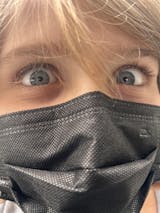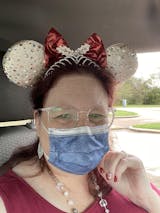












Child-Size Face Masks - USA-Made Kids 3ply
Black vs Blue/Pink masks
Our Black masks come off of a different machine line than our Blue and Pink masks, and have a slightly different form factor. These masks are made with the same care and quality materials you've come to expect from Armbrust.
Children, and those with smaller faces, should have access to the highest quality disposable face masks.
Our Pediatric Face Masks are constructed using materials that filter <95% of airborne particulates. Made from raw virgin polypropylene, our masks feature our proprietary Electrostatic Armor Meltblown filtration within the inner layer to provide the utmost protection available.
Available Colors:
Blue kids masks
Black kids Masks
Grey kids Masks
Pink kids masks
White kids masks
FEATURES:
✓ Made From the highest quality materials and tested to filter 95% of particulates
✓ Triple-layered, breathable, and lightweight
✓ Secure fit
✓ Two-way protection, w/Electrostatic Armor Filtration
✓ Made in America
✓ Triple-layered, breathable, and lightweight
✓ Metal nose bridge for secure fit & less glasses fog
✓ Two-way protection
✓ Rated at ASTM F2100 Level 3
✓ Made in America
We're here to help!
If you're not satisfied about anything at all, please don't hesitate to reach out to us at support@armbrust.com!
Earloop Issue?
Our earloops are sonically welded and held to the highest industry standard, but breakages still happen. That's why we offer an earloop guarantee - in practical terms that means if you experience any issues we will issue a pro-rated refund on a per mask basis.
Just write up the issue you're having and send a pic of the broken earloop to Support@armbrustusa.com and our team will make it right.
-------------------------
All Returns MUST begin by emailing: Support@armbrustusa.com
(Please include receipt or proof of purchase)
All sales are final with the following exceptions.
30-Day Policy: If 30 days have gone by since your purchase, unfortunately we cannot offer a refund or exchange.
Returns: Customers are responsible for paying all shipping costs for any purchased items they wish to return. We DO NOT issue return shipping labels for returned items.
Eligibility: Your item must be unused and in the same condition and original packaging. Only regular priced items may be refunded. Donation Packs are non-refundable, non-returnable. Receipt or proof of purchase is required to process all returns.
Exchanges: In some instances, items deemed defective or damaged can be replaced or exchanged. For exchanges, email support@armbrustusa.com.
There are certain situations where only partial refunds are granted: (if applicable)
- Masks with obvious signs of use
- Mask packaging that has been opened
- Any item not in its original condition, is damaged or missing parts for reasons not due to our error.
Refunds (if applicable)
Once a return is received and inspected, our support team will send a confirmation email as well as a notification on its review status.
If you are approved, a credit will automatically be applied to your credit card or original method of payment, within a certain amount of days (transaction times may vary based on payment method).
Late or missing refunds
First, check your bank account to verify refund has not gone through. Then, contact your bank or credit card company, as it may take some time before your refund is officially posted as processing times may vary. If you’ve done all of this and you still have not received your refund, please contact us at support@armbrustusa.com.










